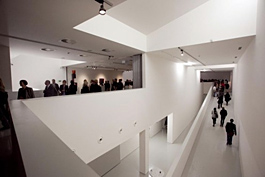
DOX has organized over 100 exhibitions in its five years of existence
 |
"The fact that DOX is accepted and respected as a fundamental and permanent part of the cultural scene in the Czech Republic," Válka responded to a question from ČTK regarding what he considers the greatest success of the institution he founded.
DOX mainly serves the function of a kunsthalle, which had long been missing in addition to the specific Rudolfinum Gallery in Prague, but it has also taken over events that previously took place in some public institutions. DOX opened in October 2008, and a program is prepared for Saturday, September 28, to commemorate the fifth anniversary of the center's founding. The afternoon will kick off with workshops with artists and creative workshops for parents and children, while the evening program will offer guided tours of exhibitions with curators and a concert with a light show. DOX will be open for free all day.
 |
"But there aren't many strong and interesting authors among young artists; a few are here, but the quality isn't overwhelming. The previous generation was somewhat more interesting, and the one before that even more so. But I think this is the case globally; it can be seen at international contemporary art exhibitions," he believes. Those who create the program at DOX are interested in art that has "some agenda, a connection to the contemporary world, society, and our perception of the role of art."
The establishment of the DOX center is well known - Válka, after returning to the Czech Republic from abroad, was seeking suitable properties as a developer, and the former factory on Osadní Street was supposed to be converted into apartments and lofts. However, the industrial space enchanted Válka in 2002, and he saw it as a future gallery. He had a clear idea of its architectural solution, which was fulfilled by Ivan Kroupa, with whom Válka had previously worked.
The DOX building was included in the Phaidon Atlas of 21st Century World Architecture among the most significant buildings in the world in 2008 and was nominated for the prestigious Mies van der Rohe Award the same year. In addition to Válka's business partner Robert Aafjes, Václav Dejčmar and Richard Fuxa joined in financing the construction.
Neither state nor Prague institutions participated in the creation of the project. Today, alongside private donations (the main sponsor of DOX is Zdeněk Bakala, who contributes a quarter of the center's forty million annual budget), it is now possible to obtain at least some funding from public sources. These account for about one-fifth of the budget. The largest share of this amount comes from Prague, which provides DOX with a four-year grant of about six million crowns per year, while the Ministry of Culture contributed 1.5 million crowns for operations this year.
"Given the overall modest volume of money distributed from public sources for our type of activity, we are relatively successful. However, considering the demands, scope, and contribution to Czech culture, where we largely supplement state institutions, this contribution is disproportionately low," says the director, adding that Prague 7, where DOX is located and which benefits the district greatly through its service and promotion, gives the center 10,000 crowns per year. "That is 0.025 percent of the annual budget and one-tenth of the daily costs of our operations," he states. He adds that more than 30 percent of visitors are foreigners.
DOX is mentioned in all well-known guides and brochures, and visitors to Prague seek it out. "They could realize that we do a lot for the promotion of Prague in the cultural area; this is currently the most rapidly developing area of tourism; tourists want to have some cultural destination and want to see not only historical architecture but also contemporary architecture, and we fulfill that perfectly," Válka conveys to the relevant officials and politicians who decide on the support of cultural activities.
The English translation is powered by AI tool. Switch to Czech to view the original text source.
0 comments
add comment












